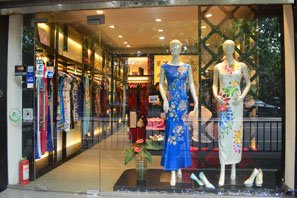Hello ladies and gents this is the Viking telling you that today we are talking about
Silk Facts
Silk is more than just a fabric in China: it is their history, their culture, fashion and a symbol of prosperity. Not only is China the world's largest producer of silk, but also silk has a huge influence on its tourism, with many silk attractions, including the Silk Road, qipaos, and Hangzhou Silk Museum.
Here are 5 fascinating facts about silk and its culture in China.
1. Silk spawned the longest ancient trade routes - the Silk Road.
The Silk Road had its beginnings around 130 BC when the Han Government dispatched General Zhang Qian as an envoy to build good relationships with small nomadic states west of China.
Then Chinese transported silk, tea, and other products along the Silk Road route, to exchange them for horses with small kingdoms in the west of China.
Silk trade was confined to China until the Silk Road became the world's longest ancient overland trade route, in the latter half of the first century BC. The Silk Road actually refers to a number of ancient trade routes linking China and Central Asia, and Europe.
The Silk Road grew in influence because of the popularity of silk as one of the main products ferried through it. For instance, Romans, Greeks, and Egyptians preferred the luxuriousness of Chinese silk.
Marco Polo traveled the ancient road to bring tales and products of China back to Europe.
2. China is the world's largest silk producer.
China produces 150,000 metric tons of silk annually, making it world's largest silk producer, with 78% of the world's silk.
For thousands of years, China held a monopoly over the distribution of silk and held onto the practice for centuries. Up until the beginnings of the Tang Dynasty, no other nation in the world knew how to make silk and relied on China for silk.
3. Silk has profoundly influenced Chinese fashion.
Silk has long been the epicenter of fashion in China, with Shanghai being the silk fashion capital, although it is also used in other cities.
Silk is used to produce qipaos, which became popular in Shanghai in the interwar period, and are still popular as evening wear or party attire in China.
Young designers like Uma Wang and Christine Lau use silk designs to offer statements on feminism.
The best places to buy qipaos are in Shanghai. You can also tailor-make a qipao in Beijing and other cities as well.
4. Silk was reputedly discovered in a cup of tea.
As narrates Confucius, Lei Zu, who was the wife of the Yellow Emperor Huangdi, discovered silk in 2,700 BC after a cocoon dropped into her tea, and, as she attempted to pull it out, silk thread unraveled. Whether the account is true or not, Lei Zu is now renowned through China as the Goddess of Silkworms (Seini-Than).
China not only discovered silk long ago, but also pioneered silk dyeing in different colors.
During ancient times, white silk was achieved by feeding home-grown silkworms only with leaves of white (garden) mulberry during the breeding period. To get yellow silk, the silkworms were fed with Je tree (wild mulberry growing in mountains) leaves during the first half of their life, and garden mulberry leaves in the second.
Ancient Chinese also used to dye fabrics using natural dye sources such as red dye from madder root, yellow from Jinzi fruits, dark red from ochre, and white from mineral dye.
5. Silk is still made the same way it always has been.
Sericulture is the raising of silkworms and unwinding of their cocoons. After over three thousand years, Chinese silk is still manufactured from intensive silkworm care. However, the process has now been mechanized.
The level of care determines the quality of silk. The eggs are soaked in chemicals to hasten hatching, then the worms are fed with mulberry leaves regularly.
The worms are kept in rooms at a temperature between 24–27°C (75–80°F) and the room is lighted around the clock. The rooms must also be kept clean and the worms are kept free from drafts, smoke, odors, and noise.
During their three to eight day pupating period, the silkworm secretes filament meant to be a part of its cocoon that stretches one kilometer in length. This is then combined with modern chemical processes used to strengthen the silk. Unfortunately, silkworms are killed in this process, more than ten billion of them each year.

Comments
Post a Comment